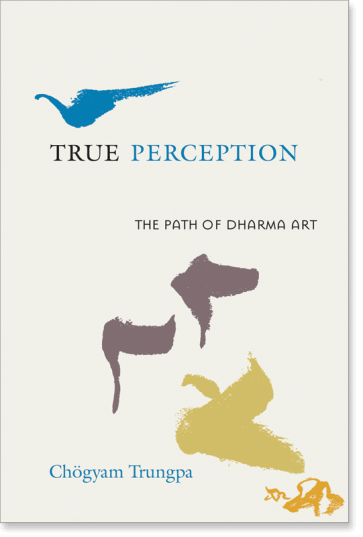
Source Materials and Other Resources
Source Materials and Other Resources
These materials provide the basis for Shambhala Art teachings and help to further expand and explain them. In general, we highly recommend True Perception, a collection of talks given by Chogyam Trungpa Rinpoche, as both a starting and returning point for those interested in Shambhala Art. Some resources are currently out print, but can be found as used copies (or in volumes of the Collected Works).
Below are Books, Commercial Videos, & Program Videos.
Books
True Perception
Genuine art has the power to awaken and liberate. The renowned meditation master and artist Chogyam Trungpa called this type of art “dharma art”—any creative work that springs from an awakened state of mind, characterized by directness, unselfconsciousness, and nonaggression. Dharma art provides a vehicle to appreciate the nature of things as they are and express it without any struggle or desire to achieve. A work of dharma art brings out the goodness and dignity of the situation it reflects—dignity that comes from the artist’s interest in the details of life and sense of appreciation for experience. Trungpa shows how the principles of dharma art extend to everyday life: any activity can provide an opportunity to relax and open our senses to the phenomenal world.
An expanded edition of Trungpa's Dharma Art (1996), this book includes a new introduction and essay.
The Collected Works of Chögyam Trungpa: Volume Seven
The Collected Works of Chogyam Trungpa brings together in ten volumes the writings of one of the first and most influential and inspirational Tibetan teachers to present Buddhism in the West.
Volume Seven features the work of Chogyam Trungpa as a poet, playwright, and visual artist and his teachings on art and the creative process, which are among the most innovative and provocative aspects of his activities in the West. While it includes material in which Trungpa Rinpoche shares his knowledge of the symbolism and iconography of traditional Buddhist arts (in Visual Dharma), this richly varied volume primarily focuses on his own, often radical creative expressions. The Art of Calligraphy is a wonderful showcase for his calligraphy, and Dharma Art brings together his ideas on art, the artistic process, and aesthetics. Tibetan poetics, filmmaking, theater, and art and education are among the topics of the selected writings.
Secret Beyond Thought
Secret Beyond Thought is an edited transcript of a two-talk public seminar Vidyadhara Chogyam Trungpa Rinpoche taught in Boston, Massachusetts in February 1971. The first talk is an excellent introduction to the tantric principles of the chakra system. Specifically, the Vidyadhara addresses how it embodies the five awakened aspects of body, speech, mind, quality, and action. The second talk offers a unique teaching on the four karmas—or enlightened activities—and how they can either conquer or be perverted by the four maras, our personal demons and habitual patterns of ego-fixation.
Note: This book is also included in The Collected Work of Chogyam Trungpa, Volume 6. It is recommended for those who are taking Parts 4 and 5 of Shambhala Art training.
Dharma Art Conference Talks
In July 1996 a group of longtime Dharma Art students of Chogyam Trungpa Rinpoche gathered at Shambhala Mountain Center to create the foundations of what would become the Shambhala Art program. This booklet contains two talks given by Sakyong Mipham Rinpoche to the participants.
Place Your Thoughts Here
In Place Your Thoughts Here, Steven Saitzyk describes how meditation enhances creativity and artistic process. With this capacity for fresh perception, we can see and experience our world and the art that captures it in ways that touch us profoundly. This leads us to genuine spontaneity and pure, unselfconscious expression. It also dissolves creative blockages, reveals the source of creativity, and offers a path toward the sublime—through which we experience ecstatic feelings of union with ourselves, our process, and our art.
Video and Audio Recordings
Discovering Elegance
Discovering Elegance is a film directed by Chogyam Trungpa Rinpoche. In it, he demonstrates the art of oriental design, calligraphy, flower arrangement, and object placement in preparing an environmental art exhibit at the Los Angeles Institute of Contemporary Art in 1981.
Visual Dharma
In this 1978 seminar given at Naropa University, Trungpa Rinpoche talks about the artist's state of mind and how to bring the view of basic goodness to art's practice and appreciation. To illustrate his approach, he demonstrates calligraphy, arranges flowers and objects, reads and talks about poetry, and shows slides from both Western and Asian art. Special features include demonstrations and discussions of dharma art from earlier seminars.
True Perception: Iconography of Buddhist Tantra
As both an artist and a Buddhist teacher, Chogyam Trungpa developed a unique view of aesthetics and art, viewing art in everyday life as a fundamental discipline. Trungpa Rinpoche’s view of perception is expressed in these ten talks on symbolism and iconography. This seminar from Naropa University’s second summer of programs in 1975 is among his earliest teachings on art-making. Included here are the original color images from the seminar, which feature both traditional Tibetan art and his own photographs. Portions of these talks were also included in the book True Perception from Shambhala Publications, 2008.
Shambhala Art YouTube Channel
In order to view addition videos, click the ≡ symbol in the upper left hand corner.







